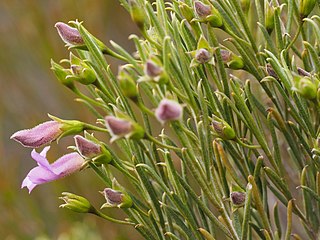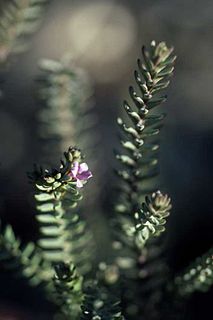
Eremophila divaricata, also known as spreading emu bush, is a flowering plant in the figwort family, Scrophulariaceae and is endemic to Australia. It is a shrub with stiff, spreading, tangled branches which are often spiny on their ends, erect leaves and mauve to lilac-coloured flowers.

Eremophila scoparia, commonly known as silver emubush, is a flowering plant in the figwort family, Scrophulariaceae and is endemic to Australia. It is a broom-like shrub with narrow, hooked leaves, small sepals and deep lilac-coloured to white petals and is common and widespread in southern parts of the continent.

Eremophila microtheca, also known as heath-like eremophila, is a flowering plant in the figwort family, Scrophulariaceae and is endemic to Western Australia. It is an erect shrub with densely hairy branches and leaves, narrow leaves and pale lilac-coloured flowers and which emits a strong odour.

Eremophila caerulea, commonly known as spotted eremophila, is a flowering plant in the figwort family, Scrophulariaceae and is endemic to the south-west of Western Australia. It is a low, compact, spreading shrub with narrow, warty, cylindrical leaves and blue to purple flowers.

Eremophila glutinosa, commonly known as sticky emu bush, is a flowering plant in the figwort family, Scrophulariaceae and is endemic to Western Australia. It is an erect, densely foliaged shrub with branches and leaves sticky and shiny due to the presence of resin. It has hairy sepals and lilac-coloured flowers.

Eremophila granitica, commonly known as granite poverty bush and thin-leaved poverty bush is a flowering plant in the figwort family, Scrophulariaceae and is endemic to Western Australia. It is an erect, open shrub with sticky, narrow leaves and with lilac-coloured flowers.

Eremophila interstans is a flowering plant in the figwort family, Scrophulariaceae and is endemic to Australia. It is a shrub or small tree found in Western Australia and South Australia and has narrow leaves with a hooked end, and white or cream-coloured flowers.

Eremophila labrosa is a flowering plant in the figwort family, Scrophulariaceae and is endemic to Western Australia. It is a shrub with many hairy branches arising from near ground level, narrow, hooked leaves and mauve and blue flowers.

Eremophila lanceolata is a flowering plant in the figwort family, Scrophulariaceae and is endemic to Western Australia. It is a low, spreading shrub with foliage which is shiny when young, angular branches and lilac to purple flowers and which grows in the north-west of Western Australia.

Eremophila margarethae, commonly known as sandbank poverty bush, is a flowering plant in the figwort family, Scrophulariaceae and is endemic to Western Australia. It is a low, spreading shrub with grey leaves, flowers a shade of pink or purple, common in central areas of Western Australia.
Eremophila metallicorum, commonly known as miners poverty bush, is a flowering plant in the figwort family, Scrophulariaceae and is endemic to Western Australia. It is a small shrub with narrow leaves and lilac-coloured flowers on an S-shaped stalk.
Eremophila pungens is a flowering plant in the figwort family, Scrophulariaceae and is endemic to Australia. It is an erect, sticky shrub with broad, serrated-edged leaves which end in a sharp spine and purple or violet flowers.

Eremophila punicea, commonly known as crimson eremophila, is a flowering plant in the figwort family, Scrophulariaceae and is endemic to Australia. It is a small, bushy shrub with small grey leaves, hairy branches and attractive pink flowers growing in areas east of Geraldton.

Eremophila resinosa, also known as resinous eremophila, is a flowering plant in the figwort family, Scrophulariaceae and is endemic to Western Australia. It is a spreading shrub with sticky young foliage, short leaves, small sepals and mauve, purple or sometimes white flowers.

Eremophila reticulata is a flowering plant in the figwort family, Scrophulariaceae and is endemic to Western Australia. It is a dense shrub with egg-shaped leaves, colourful sepals and white or pink flowers.
Eremophila retropila is a flowering plant in the figwort family, Scrophulariaceae and is endemic to Western Australia. It is an erect, spreading shrub with hairy, greyish leaves crowded at the ends of the branches, and lilac or violet-coloured flowers which are white inside.

Eremophila saligna, commonly known as willowy eremophila, is a flowering plant in the figwort family, Scrophulariaceae and is endemic to Western Australia. It is an upright shrub with narrow, serrated leaves, cylindrical flowers and cream to white petals.

Eremophila sargentii is a flowering plant in the figwort family, Scrophulariaceae and is endemic to Western Australia. It is a shrub with sticky, shiny foliage, small leaves and mauve or blue flowers.

Eremophila ternifolia, commonly known as Wongan eremophila is a flowering plant in the figwort family, Scrophulariaceae and is endemic to Western Australia. It is a low, many-branched, shrub with short, pointed leaves and small lilac-coloured or mauve flowers.

Eremophila veronica, commonly known as veronica-like eremophila, is a flowering plant in the figwort family, Scrophulariaceae and is endemic to Western Australia. It is a low, spreading shrub with small, crowded leaves and lilac-coloured flowers which have a short petal tube and spreading petal lobes.


















